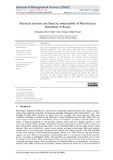| dc.description.abstract | This study investigated the effect of financial structure on microfinance firms’
financial sustainability. The study utilized panel data from 32 Microfinance
Institutions (MFIs), resulting in 320 firm-year observations for the period of 2010-
2019. The dataset was obtained from MIX market, a global database that collects
self-reported information from MFIs. The study used a battery of panel data
regression methods to test the hypotheses. The regression analysis indicated a
statistically significant negative association between debts and donations and the
financial sustainability of MFIs in Kenya. In contrast, there was a positive
relationship between deposits and equity and the sustainability of microfinance
firms in Kenya. Therefore, MFIs are strongly advised to prioritize internal
financing in order to achieve financial sustainability. In addition, it is advisable for
MFIs to avoid excessive dependence on donations and commercial funding, as
these sources of funds often come with strict requirements and conditions that
could impede their progress towards achieving financial stability. The results of
this study can offer valuable insights to MFIs managers and regulators in
formulating financing strategies that can assist MFIs in achieving financial
sustainability. | en_US |

